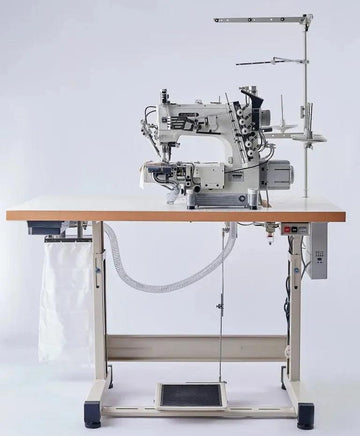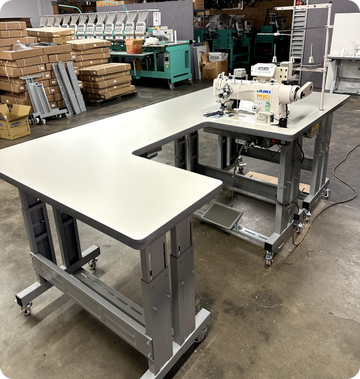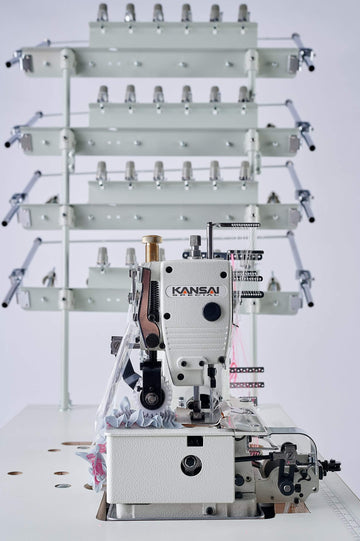Industrial sewing machines are built for speed, strength, and durability, but they need the right maintenance to keep performing well. One of the most important parts of that maintenance is oiling. If you’ve ever wondered how to oil an industrial sewing machine, what oil to use, or where to oil an industrial sewing machine, this guide covers everything you need to know.
Do All Industrial Sewing Machines Need Oil?
Not every industrial sewing machine requires oiling. Some modern models use nylon or self-lubricating joints and are designed to run oil-free. In that case, oil is unnecessary — and adding it can actually attract lint and dust.
However, traditional industrial sewing machines and most heavy-duty models still rely on lubrication. For these machines, knowing where to oil an industrial sewing machine is essential for smooth stitching and long-term reliability.
What Is Industrial Sewing Machine Oil?
Industrial sewing machine oil is a specially formulated, lightweight mineral oil. It’s designed to:
-
Prevent rust and corrosion
-
Reduce friction between fast-moving metal parts
-
Avoid gumming up or leaving residue on fabric
Most high-quality sewing machine oils are crystal clear. If your oil looks yellow, thick, or sticky, it’s time to replace it. That’s why many ask: Should industrial sewing machine oil be clear or yellow? The answer: it should be clear.
What Oil to Use for Industrial Sewing Machine
Always choose dedicated industrial sewing machine oil. Household oils, vegetable oils, or motor oils are not suitable because they can damage parts, gum up, and ruin fabrics.
Can You Use an Industrial Sewing Machine Oil Substitute?
In emergencies, some people use lightweight mineral oil as a substitute, but this is not recommended for long-term use. The safest option is always sewing-specific oil.
Where to Buy Industrial Sewing Machine Oil
You can purchase industrial sewing machine oil at:
-
Sewing machine dealers or repair shops
-
Online retailers (Amazon, eBay, specialty sewing suppliers)
-
Local sewing and quilting stores
-
Industrial supply shops
When searching, look for terms like clear sewing machine oil, low-viscosity sewing oil, or specific brand recommendations (e.g., Lily White).
Industrial Sewing Machine Oil Viscosity
The viscosity of sewing machine oil is very low — much thinner than motor oil. This allows it to seep into small moving parts quickly without creating buildup. Low-viscosity oil ensures your machine runs at high speeds without overheating.
Is There a Difference Between Industrial and Commercial Sewing Machine Oil?
In most cases, “industrial” and “commercial” sewing machine oil refer to the same product. Both are lightweight, clear oils formulated for high-speed machines. Just make sure you are buying oil specifically labeled for sewing machines.
Where to Oil Industrial Sewing Machine
Typical oiling points include:
-
Hook race and bobbin area – A few drops help reduce friction.
-
Needle bar and presser foot mechanism – Keeps vertical movements smooth.
-
Drive shaft and gears (if metal, not nylon) – Prevents wear.
-
Oil pan (for automatic lubrication systems) – Some industrial machines use a reservoir. Always check the fill line to avoid overfilling.
For machines with a built-in oil pan, owners often ask: How much oil do you need in the pan of an industrial sewing machine? The answer: just enough to reach the indicated line inside the sump — never overfill.
When to Change Oil in an Industrial Sewing Machine
If your machine has an oil pan or automatic lubrication system, the oil should be replaced periodically. As a rule of thumb:
-
Light use: Change every 6–12 months.
-
Heavy production use: Change every 3–6 months.
Dark, dirty, or yellowing oil should always be replaced immediately.
How to Change Oil on Industrial Sewing Machine
-
Turn off and unplug the machine.
-
Drain old oil from the oil pan/reservoir.
-
Clean the pan with a lint-free cloth to remove sludge or lint.
-
Refill with fresh, clear industrial sewing machine oil up to the indicator line.
-
Run the machine briefly to circulate oil before sewing again.
How to Oil Industrial Clutch Sewing Machine Motor
Clutch motors themselves generally don’t require oiling — they are either sealed or use grease internally. However, the sewing machine head (which the motor powers) still needs oil at the recommended points. Always check the machine’s manual before attempting to lubricate motor parts.
Industrial Sewing Machine Oil Recommendations
Some of the most recommended options include:
-
Lily White Sewing Machine Oil – widely used, non-staining, and clear.
-
Zoom Spout Oiler – comes with an extendable spout for hard-to-reach places.
-
Singer All-Purpose Machine Oil – good for both home and industrial use.
Final Tips
-
Always use clear sewing machine oil.
-
Do not substitute with motor oil, WD-40, or cooking oil.
-
Regular cleaning is just as important as oiling.
-
Check your machine manual or a similar model for exact oiling points.
-
When in doubt, ask a sewing technician for help.
Conclusion
Knowing how to oil an industrial sewing machine correctly can extend its life, prevent breakdowns, and keep stitches consistent. Whether you’re running a straight-stitch industrial model, a serger, or a rebranded machine with no manual, the key is using the right oil, applying it in the right places, and replacing it regularly.
With the right care, your machine will run smoothly for years — whether you’re sewing upholstery, garments, or heavy-duty materials.










